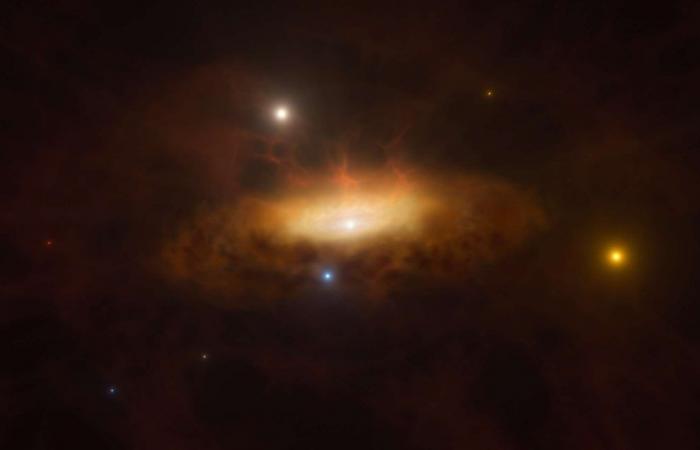As we have suspected for more than 50 years, we know today that the vast majority of large galaxies have at their heart at least one supermassive black hole containing more than a million solar masses and sometimes several billion. It is also known that when they accrete matter in large quantities, an accretion disk is formed where the viscous friction between the spiral gas streams falling towards theevent horizonevent horizon release a lot of heatheat to the point of ionizing matter and producing strong radiation.
As the central black hole is also rotating, the plasma produced by theionizationionization matter – in conjunctionconjunction with this rotation which affects the state of thespace-timespace-time around the black hole – becomes the object of magnetohydrodynamic processes also producing intense radiation and even accelerating particles forming jets of matter.
We transiently obtain what we call a active galaxy coreactive galaxy core and when it is particularly bright, a quasar. We can think that this was the case in the past of the supermassive black hole Sgr A* of the Milky WayMilky Way.
These processes are not yet fully understood and questions also arise about the exact mechanisms of food in terms of accretion diskaccretion disk. The dominant paradigm currently is that with cold currents of black matterblack matter. Finally, we know that there are connections between the evolution of galaxies and that of supermassive black holessupermassive black holes.
This video zooms in on the galaxy SDSS1335+0728, which in late 2019 suddenly began to shine brighter than ever and was classified as having an active galactic nucleus. An inset at the end of the second video below shows an artist’s animation of the massive black hole at the center of the galaxy, with the growing disk of material being attracted to the black hole as it feeds on the gas available in its environment. This is the first time that the awakening of a massive black hole has been observed in real time. The images shown here were taken with different telescopes at different times, and have been blended to create this zoom. The final animation is an artistic creation. © ESO, L. Calçada, M. Kornmesser, N. Risinger (skysurvey.org), SDSS, Space Engine (spaceengine.org). Music: Astral Electronic
A new AGN observed since 2019
Still, the astrophysicistsastrophysicists are slowly but surely pushing back the frontiers of our knowledge about these active galactic nuclei, AGN according to the acronym of the English translation of this name, as we can see with the publication of an article in Astronomy & Astrophysics about the observed AGN, which in the catalog of the famous Sloan DigitalDigital Sky Survey sees its galaxy designated as SDSS1335+0728.
It talks about observations carried out since December 2019 and which suggest to astrophysicists that they have surprised the awakening of a supermassive black hole in real time, therefore becoming an AGN located at 300 millionlight yearslight years in the Virgo constellationVirgo constellation.
The discovery is commented on by an article from theESOESO in which we learn, for example, that the start of the variation of brightnessbrightness unusual SDSS1335+0728 was detected by the telescopetelescope Zwicky Transient Facility (ZTF) in the United States. Several ground-based instruments in space were then used to understand what was going on, including by looking at archives of their observations. In this regard, we can cite the eRosita instrument on the Spektr-RG space observatory, the VLTVLT of ESO of course, but also the Chandra X-ray Observatory of the NASANASA.
Artist’s animation of the black hole at the center of SDSS1335+0728 waking up in real time. © ESO, L. Calçada, M. Kornmesser
We can read in the ESO press release the statements of Paula Sánchez Sáez, astronomerastronomer at ESO in Germany and lead author of the study on SDSS1335+0728: “ Imagine that you have been observing a distant galaxy for years and it has always seemed calm and inactive. Suddenly, its core begins to show dramatic changes in brightness, unlike any typical events we’ve seen before. »
Indeed, in the case of other events with a strong increase in known luminosity, such as supernovaesupernovae or the destruction of a starstar by the tidal forcestidal forces of a supermassive black hole according to the scenario of Tidal disruption events (or TDE, which can be translated as “tidal rupture event” – Jean-Pierre Luminet was one of the pioneers of the theoretical study of these TDEs almost 40 years ago with one of the great theorists black holes, the Australian Brandon Carter) – variations in luminosity generally last only a few dozen or at most a few hundred days.
However, the galaxy SDSS1335+0728 continues to light up today, more than four years after being seen for the first time “lighting up”, explains the ESO press release which also specifies that in Comparing data taken before and after December 2019, astrophysicists found that the galaxy now radiates much more light in the wavelengthswavelengths ultraviolet, optical and infraredinfraredand since February 2024 also in X-raysX-rays.
A quasar that lights up live?
This is unheard of ! For Lorena Hernández García, of the Institute ofastrophysicsastrophysics of the Millennium (MAS) and the University of Valparaíso in Chile, co-author of the study: “ The most tangible option to explain this phenomenon is that we see how the core of the galaxy begins to show activity. If so, it would be the first time we have seen the activation of a massive black hole in real time. »
Which also makes his colleague Claudio Ricci, from Diego Portales University, also in Chile, say: “ These giant monsters are usually asleep and not directly visible. In the case of SDSS1335+0728, we were able to observe the awakening of the massive black hole, which suddenly began to feed on the gas available in its environment, thus becoming very luminous. This is something that could also happen to our own Sgr A*Sgr A*the massive black hole located at the center of our Galaxy. »
The ESO press release cautiously concludes by stating that “ further observations are still needed to rule out other explanations. It is also possible that we will see an unusually slow tidal disruption, or even a new phenomenon. If it is indeed a tidal disturbance, it would be the longest and weakest event ever observed “.
Paola Sánchez Sáez adds: “ We hope that instruments like Muse on the VLT or those of the future Extremely Large Telescope (ELTELT) will be essential to understanding why the galaxy shines. »
To know :
In 1963, Maarten Schmidt and John Beverly Oke published in the newspaper Nature the results of the observations that they had made using in particular the technique of occultationsoccultations. They sought to determine the optical counterpart of a powerful radio source discovered a few years earlier by another astronomer, Alan Sandage. The source was named 3C 273, which means it was 273e subject of the third Cambridge catalog listing radio sources.
Schmidt and Oke’s article was a coup thunderthunder in the sky of astrophysics and cosmologycosmology. Spectral analysis of thestarstar that they had identified in the visible in the Virgo constellation revealed lines ofemissionemission of the’hydrogenhydrogen strongly redshifted. This meant that what appeared as a star was located outside the Milky Way, but above all at a cosmological distance. To be observable from so far away, the object must have been of prodigious luminosity.
The 3C 273 quasar, proof of the Big Bang theory
This discovery of a quasi-stellar radio sourceA quasar according to the name proposed in 1964 by the astrophysicist of Chinese origin Hong Yee Chiudemonstrated that theUniverseUniverse was different in the past, and therefore evolved. This was not possible within the framework of standard cosmological modelstandard cosmological model of the time, according to which, although expanding, the Universe must appear unchanged to all its observers, whatever their position in time. On the other hand, the existence of 3C 273 was in perfect agreement with the theory of big Bang, since this predicted that if we observed objects at sufficiently large distances, we went back further and further into the past and the history of an evolving universe. It was therefore normal to observe billions of light years away a Universe whose appearance differs from that which it had only a few tens of millions of years ago, therefore in the environment close to the Milky Way. .






